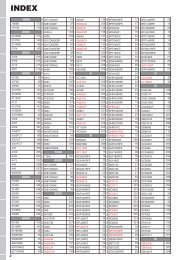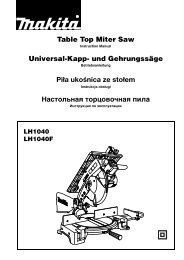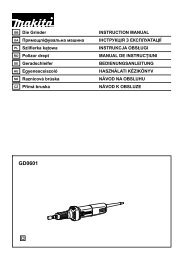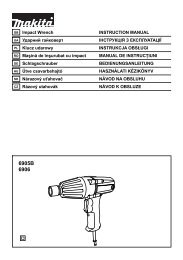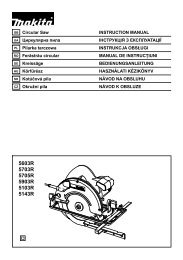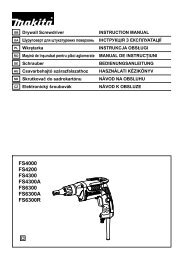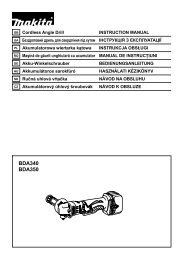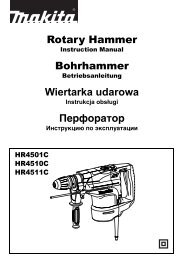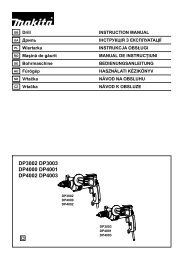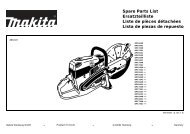Rotary Hammer Bohrhammer Wiertarka udarowa Перфоратор
Rotary Hammer Bohrhammer Wiertarka udarowa Перфоратор
Rotary Hammer Bohrhammer Wiertarka udarowa Перфоратор
Sie wollen auch ein ePaper? Erhöhen Sie die Reichweite Ihrer Titel.
YUMPU macht aus Druck-PDFs automatisch weboptimierte ePaper, die Google liebt.
Indicator lamp (Fig. 9)<br />
The green power-ON indicator lamp lights up when the<br />
tool is plugged. If the indicator lamp does not light up, the<br />
mains cord or the controller may be defective. The<br />
indicator lamp is lit but the tool does not start even if the<br />
tool is switched on, the carbon brushes may be worn out,<br />
or the controller, the motor or the ON/OFF switch may be<br />
defective.<br />
The red service indicator lamp lights up when the carbon<br />
brushes are nearly worn out to indicate that the tool needs<br />
servicing. After approx. 8 hours of use, the motor will<br />
automatically be shut off.<br />
ASSEMBLY<br />
CAUTION:<br />
• Always be sure that the tool is switched off and<br />
unplugged before carrying out any work on the tool.<br />
Side handle (Fig. 10)<br />
CAUTION:<br />
• Use the side handle only when chipping, scaling or<br />
demolishing. Do not use it when drilling in concrete,<br />
masonry, etc. The tool cannot be held properly with this<br />
side handle when drilling.<br />
The side handle can be swung 360° on the vertical and<br />
secured at any desired position. It also secures at eight<br />
different positions back and forth on the horizontal. Just<br />
loosen the clamp nut to swing the side handle to a desired<br />
position. Then tighten the clamp nut securely. (Fig. 11)<br />
Side grip (Fig. 12)<br />
CAUTION:<br />
• Always use the side grip to ensure operating safety<br />
when drilling in concrete, masonry, etc.<br />
The side grip swings around to either side, allowing easy<br />
handling of the tool in any position. Loosen the side grip<br />
by turning it counterclockwise, swing it to the desired<br />
position and then tighten it by turning clockwise.<br />
Installing or removing the bit (Fig. 13)<br />
Clean the bit shank and apply bit grease before installing<br />
the bit.<br />
Insert the bit into the tool. Turn the bit and push it in until it<br />
engages. (Fig. 14)<br />
If the bit cannot be pushed in, remove the bit. Pull the<br />
chuck cover down a couple of times. Then insert the bit<br />
again. Turn the bit and push it in until it engages.<br />
After installing, always make sure that the bit is securely<br />
held in place by trying to pull it out.<br />
To remove the bit, pull the chuck cover down all the way<br />
and pull the bit out. (Fig. 15)<br />
Bit angle (when chipping, scaling or<br />
demolishing) (Fig. 16 & 17)<br />
The bit can be secured at 12 different angles. To change<br />
the bit angle, depress the lock button and rotate the<br />
change lever so that the pointer points to the symbol.<br />
Turn the bit to the desired angle.<br />
Depress the lock button and rotate the change lever so<br />
that the pointer points to the symbol. Then make sure<br />
that the bit is securely held in place by turning it slightly.<br />
(Fig. 18 & 19)<br />
8<br />
Depth gauge (Fig. 20)<br />
The depth gauge is convenient for drilling holes of uniform<br />
depth. Loosen the clamp screw and adjust the depth<br />
gauge to the desired depth. After adjusting, tighten the<br />
clamp screw firmly.<br />
NOTE:<br />
• The depth gauge cannot be used at the position where<br />
the depth gauge strikes against the gear housing/motor<br />
housing.<br />
OPERATION<br />
<strong>Hammer</strong> drilling operation (Fig. 21)<br />
Set the change lever to the symbol.<br />
Position the bit at the desired location for the hole, then<br />
pull the switch trigger. Do not force the tool. Light<br />
pressure gives best results. Keep the tool in position and<br />
prevent it from slipping away from the hole.<br />
Do not apply more pressure when the hole becomes<br />
clogged with chips or particles. Instead, run the tool at an<br />
idle, then remove the bit partially from the hole. By<br />
repeating this several times, the hole will be cleaned out<br />
and normal drilling may be resumed.<br />
CAUTION:<br />
• When the bit begins to break through concrete or if the<br />
bit strikes reinforcing rods embedded in concrete, the<br />
tool may react dangerously. Maintain good balance<br />
and safe footing while holding the tool firmly with both<br />
hands to prevent dangerous reaction.<br />
Blow-out bulb (optional accessory)<br />
(Fig. 22)<br />
After drilling the hole, use the blow-out bulb to clean the<br />
dust out of the hole.<br />
Chipping/Scaling/Demolition (Fig. 23)<br />
Set the change lever to the symbol.<br />
Hold the tool firmly with both hands. Turn the tool on and<br />
apply slight pressure on the tool so that the tool will not<br />
bounce around, uncontrolled. Pressing very hard on the<br />
tool will not increase the efficiency.<br />
MAINTENANCE<br />
CAUTION:<br />
• Always be sure that the tool is switched off and<br />
unplugged before attempting to perform inspection or<br />
maintenance.<br />
• This servicing should be performed by Makita<br />
Authorized Service Centers only.<br />
This tool requires no hourly or daily lubrication because it<br />
has a grease-packed lubrication system. It should be<br />
relubricated after requlary. Send the complete tool to<br />
Makita Authorized Service Center for this lubrication<br />
service.<br />
To maintain product SAFETY and RELIABILITY, repairs,<br />
any other maintenance or adjustment should be<br />
performed by Makita Authorized Service Centers, always<br />
using Makita replacement parts.



